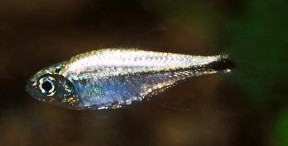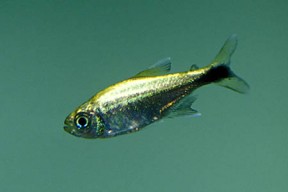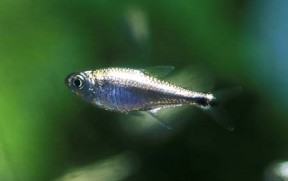Hemigrammus rodwayi
Golden Tetra
Classification
Characidae
Distribution
Native to Guyana, Suriname, French Guiana, Peru and Brazil.
Habitat
Slow moving rivers, tributaries and floodplain lakes. It’s abundant in coastal floodplains, where it’s sometimes found in mildly brackish conditions.
Maximum Standard Length
2.2″ (5.5cm).
Aquarium SizeTop ↑
A small group would need a tank around 24″ x 15″ x 12″ (60cm x 37.5cm x 30cm) – 70 litres in size.
Maintenance
A biotope setup would be very simple to arrange. Use a substrate of river sand and add a few driftwood branches (if you can’t find driftwood of the desired shape, common beech is safe to use if thoroughly dried and stripped of bark) and twisted roots. A few handfuls of dried leaves (again beech can be used, or oak leaves are also suitable) would complete the natural feel. Aquatic plants are not a feature of this species‘ natural waters. Allow the wood and leaves to stain the water the colour of weak tea, removing old leaves and replacing them every few weeks so they don’t rot and foul the water. A small net bag filled with aquarium-safe peat can be added to the filter to aid in the simulation of black water conditions. Use fairly dim lighting.
Alternatively, it also does well in a well maintained, heavily planted tank or peaceful community setup.
Water Conditions
Temperature: 75-82°F (24-28°C)
pH: 5.5-7.0
Hardness: 1-12°H
Diet
Easy to feed. It will readily accept just about anything offered. For the best condition and colours offer regular meals of small live and frozen foods such as bloodworm, Daphnia and brine shrimp, along with dried flakes and granules.
Behaviour and CompatibilityTop ↑
It’s a very peaceful species that won’t compete well with very boisterous or much larger tankmates. Ideally, keep it with other South American species, such as other Hemigrammus or Hyphessobrycon species, pencil fish, Apistogramma dwarf cichlids, Corydoras and small Loricariids. In a more general community it can be combined with smaller rasboras, barbs, Anabantoids and West African dwarf cichlids such as Pelvicachromis species.
Always buy a group of at least 6 of these, preferably 10 or more. It is a shoaling species by nature, and will fare much better when in the company of its own kind. Like most tetras it actually looks far more effective when maintained like this anyway.
Sexual Dimorphism
Adult females are more rounded in the belly than males. The anal fin of the male has a white leading edge, and contains more red pigmentation than that of the female.
Reproduction
Can be bred in a similar way to other species in the genus. You’ll need to set up a separate tank if you want to raise decent numbers of fry. Something around 18″ x 10″ x 10″ in size is fine. This should be very dimly lit and contain clumps of fine-leaved plants such as java moss or spawning mops, to give the fish somewhere to deposit their eggs. Alternatively, you could cover the base of the tank with some kind of mesh. This should be of a large enough grade so that the eggs can fall through it, but small enough so that the adults cannot reach them. The water should be soft and acidic in the range pH 5.5-6.5, gH 1-5, with a temperature of around 80-84°F. Filtering the water through peat is useful, as is the use of RO water. A small air-powered sponge filter bubbling away very gently is all that is needed in terms of filtration.
It can be spawned in a group, with half a dozen specimens of each sex being a good number. Condition these with plenty of small live foods and spawning should not present too many problems.
Alternatively, it can be spawned in pairs. Under this technique, the fish are conditioned in male and female groups in separate tanks. When the females are noticeably full of eggs and the males are displaying their best colours, select the fattest female and best-coloured male and transfer them to the spawning tank in the evening. They should spawn the following morning.
In either situation, the adults will eat the eggs given the chance and should be removed as soon as eggs are noticed. These will hatch in 24-36 hours, with the fry becoming free swimming a 3-4 days later. They should be fed on an infusoria–type food for the first few days, until they are large enough to accept microworm or brine shrimp nauplii. The eggs and fry are light sensitive in the early stages of life and the tank should be kept in darkness if possible.
NotesTop ↑
This species has something of a confused taxonomic past. The standard colour of the fish is a rather dull silvery grey, with a little colour in the fins. However in certain areas in nature, the species is sensitive to a particular type of trematode parasite. This causes a reaction in the skin of the fish, resulting in a spectacular metallic gold colouration formed by deposits of guanin. When initially discovered, these golden fish were mistakenly described as a new species, Hemigrammus armstrongi. This is now considered a junior synonym of H. rodwayi.
Unfortunately, captive bred specimens do not exhibit this colouration, as they are not exposed to the parasite. This is why most of the ‘golden tetras’ seen for sale do not live up to the common name stated on the tank. Infected wild caught fish are available from time to time, and are truly stunning.
Like all Hemigrammus, the taxonomic status of this species is currently Incertae Sedis, meaning uncertain. The genus is currently used as something of a catch-all for over 70 species of small characin. Most experts agree that a full revision is required, with the likely outcome that many species will be placed into new or different genera.





